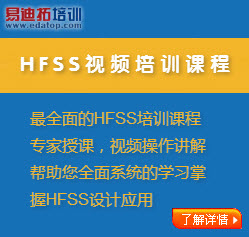额。这个问题我也遇到过
fullbook上说是离辐射体1/4波长,一般也都是这么设置的
我的辐射边界取到过半个波长左右,两者的结果是不太一样,但是没什么实质性的差异
我方的两个方向图明显不一样,但大致趋势差不多。
老师把这种现象归于软件的问题
应用别人论文中的一段话回答:
Airbox Dimensions and boundary conditions
----------------------------------------
In order to accurately simulate the behaviour of an antenna in HFSS, an airbox has to be chosen to surround the structure. The dimensions of the airbox can have a large effect on the accuracy of the results. The airbox size must not be too small and must be a certain distance away from any radiating object. Ideally an airbox size should be large, but this will increase the number of finite elements in the solution and also increase computation time. A rule of thumb for selecting the size of an airbox is that all boundaries of an airbox must be at least a quarter wavelength away from the antenna structure. In this example the resonant frequency of 1.3GHz has a quarter wavelength of 57.69 mm. An airbox size was chosen to be 60 mm away from the three sides of the radiating patch which are not connected to the feedline. If the ground plane is large then the airbox only needs to be created above the ground plane since most of the radiation takes place above the ground plane. HFSS requires that airbox boundaries be assigned as radiation surfaces in order that no reflected radiation takes place. The airbox surface which coincides with the ground plane is not selected as a radiation surface.
一般情况下从模型往外波长的十分之一就OK乐
十分之一太小了。
这个波长是那来的?是最高频率对应的还是中心频率对应的波长?
师兄说是中心频率对应的波长的四分之一
最好按最低频率对应的波长来取,在理论上认为0.25个波长处以外就是远场区
声明:网友回复良莠不齐,仅供参考。如需更专业、系统的学习HFSS,可以购买本站资深专家讲授的HFSS视频培训课程。


